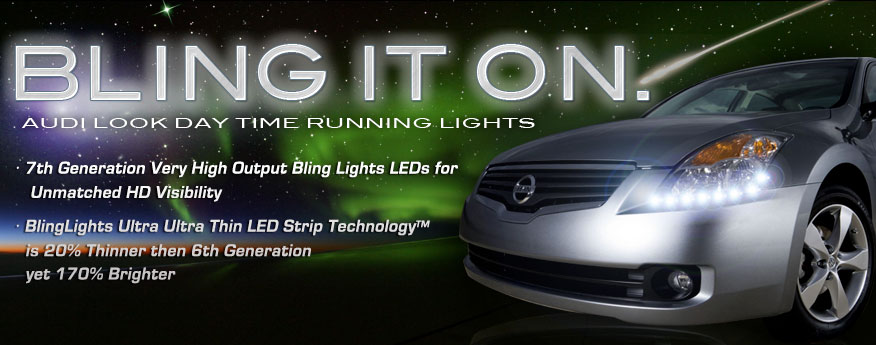Why Should I Upgrade My Automotive Lighting?
Other than your brakes, no other safety feature on your vehicle is as important as your lights. Without them, everyone's drive time would be limited to the brief period between sunrise and sunset. Workers wouldn't be able to get home in the evenings, semis would take a month to haul their load cross country, and drive-in movie theaters across the nation would be forced to close their doors.
A quality set of lights gives all of us the freedom of movement to venture out onto the road no matter what the driving conditions are. Moonless nights, foggy mornings, or stormy afternoons are no match for an arsenal of bright lights safely guiding you to your destination. Besides improving the safety of your vehicle, automotive lights give you the chance to redesign its overall look by adding new lights or altering the style and color of your existing ones.
What's the difference between driving lights and fog lights?
Driving lights work with your hi-beams for greater visibility at longer distances. They project a long, narrow beam of light in a variety of patterns which greatly extend your range of view. Fog lights work together with your low-beams to improve your visibility in foul weather, such as fog, rain, snow and mist. They emit a low, wide pattern of light that's designed to shine below the haze. This reduces the amount of blinding glare that occurs when you turn on your hi-beams in foggy weather.
Are yellow fog lights really better than white or blue ones?
The old wives' tale that yellow fog lights give you greater visibility over white or blue ones is just not true. The premise of that superstition, that yellow light waves are long enough to pass through water particles without reflecting back into the driver's eyes, is based on a misinterpretation of Lord Rayleigh's principle of light scattering. As it turns out, the water particles in fog and mist are entirely too large to have an effect on any light waves from fog lights, be they yellow, white, blue or even green. In other words, any fog light that is properly mounted and aimed is effective, so don't worry about the color.
What's HID xenon lighting and why is it better than halogen lighting?
HID is short for High-Intensity Discharge, which is an advanced, powerful and efficient lighting technology that's making the transition from the industrial to the consumer market. It works by creating an electrical arc, which then heats up a cloud of gas that's floating in the bulb. Usually, xenon gas is used because it creates an incredibly bright blue light that virtually matches the color temperature of noontime daylight. HID xenon lighting is far superior to traditional halogen lighting because it produces a brighter, more natural light that reduces eye strain and increases visibility. Most people prefer the look of HID to halogen as well.
What is the HID Color Temperature?
Color Temperature is a measurement in Degrees Kelvin that indicates the hue of a light source, in this case the HID bulb. People not familiar with lighting may believe that the higher the Kelvin the brighter the light will be, this is false. Exotic vehicles that come factory equipped with HIDs range from 4300k to 6000k HID bulbs which produce the most daylight-like light output. Lower temperature like 3000k will produce deep gold-yellow color, suitable for fog lights. Higher color temperatures will output light with a hint of blue/purple like the 6000k - 8,000k bulbs, higher rated bulbs will be bluer and eventually purple in color as you go up the scale.
How do LEDs compare to HID?
LEDs don't have a filament to burn out or break; therefore, they last much longer than conventional bulbs. Given that a very small semiconductor chip runs an LED, they are very durable and tend to last many thousands of hours. Moreover, LEDs are "instant on," much like halogen lamps, and thus convenient for use in applications that are subject to frequent or potential on-off cycling. Conversely, HID lamps are more fragile and have to warm up (15 Ð 25 seconds) during ignition. However, HID lights are much brighter than current LED configurations. This is because the side-emitting light found with HIDs is much easier to focus; the front-emitting nature of LEDs does not lend itself to a tightly focused beam. HID lighting is still preferred by most divers given the superior intensity and tight focus. However, LED technology is changing rapidly and it is foreseeable that LEDs will eventually surpass the performance of HID lighting. Both HIDs and LEDs have beautiful color but LED color stands out more than HID.
What if I've read through all the information, but I'm not sure which lights are right for my vehicle?
We are presenting you with a large dose of information, so it's understandable if you're feeling a bit like a deer in headlights by it. You are in luck, though. We have a cure for information overload: give us a call. We have a troop of highly knowledgeable Automotive Lighting Specialists standing by to answer any questions you might have about automotive lighting or any other part for your vehicle. Our toll-free number is (800) 761-0235














